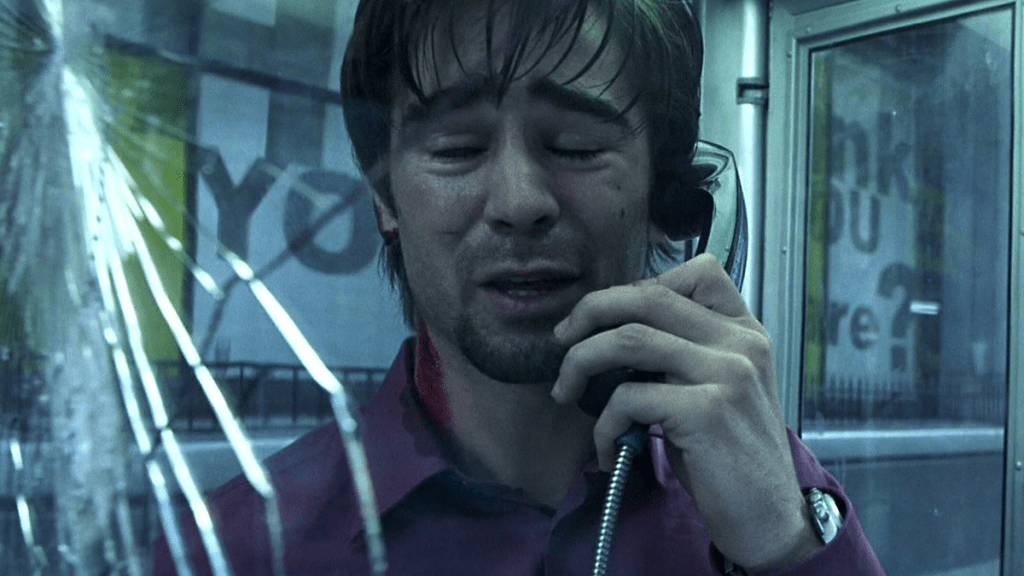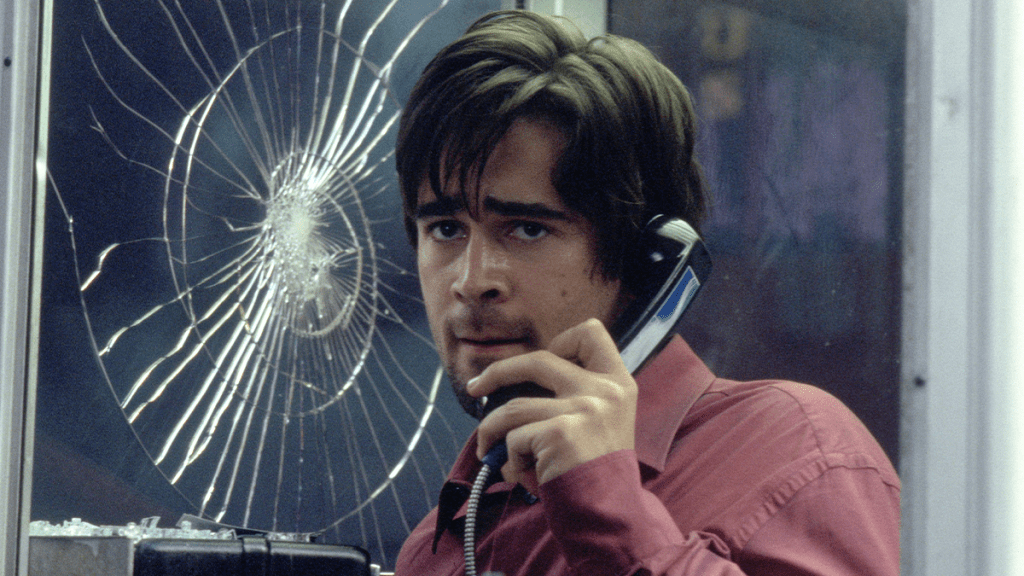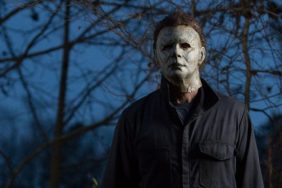There’s a certain elation that comes with finding a simple movie that sings, something with moving parts and proper flowing escalation — like a well-oiled machine. Filmmakers have been fascinated with scripts that secure actors into one location, stories that limit their movement — the smaller the better — for the storytelling challenge. It’s a chance to push visual claustrophobia onto the audience, an opportunity to use a different kind of forced tension, and, of course, a way to cut down on the budget. Phone Booth was an idea decades in the making — a project passed through several hands that was shelved even after completion. But when it did finally hit, the movie didn’t miss.
Writer Larry Cohen came up with the idea of trapping his protagonist in a phone booth over lunch with Alfred Hitchcock, but it would take him 30 years to see his vision up on the silver screen. He wanted to do this project the right way — with no flashbacks or scenes happening off in other locations. Once his character entered the box, that’s where the action would happen, and in real-time.
The story is about Stu Shepard (Colin Farrell), and an encounter that would change his life, as he makes use of the final phone booth in Manhattan’s West Side. A ringing phone has to be answered, doesn’t it? Most wouldn’t expect a sniper on the other end, though. Stu is simply an asshole publicist, so he can’t figure out why anyone would want to keep him pinned down here, toying with him, his wife Kelly (Radha Mitchell), and his mistress, Pamela (Katie Holmes). It isn’t long before someone is hurt, though, and the police are called, raising the stakes and the number of ways Stu could die.
We aren’t supposed to like our main character — not at first, at least. Stu is the type of guy who uses people to make things work for him. Everything is accomplished through manipulation and he lies without even having to think about it. He wears a nice suit, but a fake watch. This is a man that pretends to be more than he is while not paying the assistant who helps make his paper empire work, plus Stu does this all with an awkward accent that even sounds put on. We get some hints at another side of our subject, seeing him take off his wedding ring before calling the other woman he’s trying to sleep with, expressing his concern for others, and by the end, bearing his soul to the city. His deconstruction inside this small cell is the main attraction and it is handled excellently.
Joel Schumacher directed this film and it’s one of his that doesn’t get talked about enough, because some people can’t look past Batman & Robin. It’s a brisk 81 minutes that’s mostly filled with intrigue and tension, and very little feels wasted. The film is stylish and uses picture-in-picture to show what’s going on elsewhere without ever taking the focus off the main source of action. Once the plot is rolling, we never leave this block, because that’s what is important. The editing is quick and tight — a bit distracted, perhaps, but it isn’t overdone like some people usually accuse Schumacher of being. It can take a brief moment to settle, however, as even I thought the beginning was a weird music video. Regardless, after the odd narration, everything starts firing on all cylinders.
I was worried Phone Booth might feel incredibly dated at this point, and some elements definitely scream early ‘00s — like that NetZero banner — other than the object that is the focal point of the story, but the core concept and idea endures enough to make everything else work. Even though it was shot in L.A., the city of New York does some heavy lifting with its dirt and grime, using the atmosphere of a busy street with self-absorbed people to give personality to a film that stays in one spot.
Colin Farrell does a fantastic job here, starting out in control, smooth, and confident, but progressively sweating, getting grimy, and breaking down. It’s a one-man play, in some ways, unraveling like a Greek tragedy. The unseen presence forces him to go through a religious experience with a higher power — or at least a high-caliber rifle.
Kiefer Sutherland was a wonderful choice for The Caller, playing with his potential victim as his voice comes through crisper and clearer than any phone call ever has, giving weight and importance to all of his words. He is aggression and dominance with a booming voice, some detailed information, and the simple sound of the man pulling the bolt back and racking his weapon. Those few things are enough to keep Stu anxious and trembling — not to mention all of the officers pointing their guns at him. The only man on that side who believes him is Captain Ramey (Forest Whitaker), who is doing an excellent job as an actor, and as a character, not wanting to see anyone die.
Each actor was ham-stringed differently, with one tied to a booth, another only a voice until the very end, and the last having to play off of not knowing a large part of what is going on. The main three players here deserve some props.
I’m not alone in questioning the ending. It seems like the experience changes Stu for the better, even if a seemingly innocent pizza guy had to be killed to do it. The bad guy not only lives and gets away, but accomplishes his goals as well, seemingly with little complication. There’s an awkward feeling here, like the police and Stu never truly had a chance and that The Caller was infallible, but that’s not the point in the end. When Sutherland makes his way up to Stu, drugged up in the ambulance, it’s more like a supernatural predator ensuring his prey that one wrong step could mean he’d be visiting again. It’s a morality play and the lesson was going to be taught one way or another.
There was another ending, originally. A more traditional one where The Caller completes his task but dies at the end. Schumacher considered his ending perfect, however, and even supposed he might garner some hate for the lack of consequences befalling the villain. Speaking of alternate material, there is also a deleted scene where Jared Leto plays one of Stu’s clients, which is often added back in when the film is shown on television to help balance out the short runtime.
When Schumacher was initially approached to direct, he bowed out to make Flawless (1999). In the meantime, names like Steven Spielberg, The Hughes Brothers, and Mel Gibson (who would have also played the main role) were considered to helm the project, but the man that seemed most likely was Michael Bay, who wanted to move the action outside of the booth for some reason. Thankfully, this process took long enough that Schumacher was able to finish his other work and accept the job again.

There was a game of hot potato played with the lead role as well. Other than Gibson (who is name-dropped in the movie), Mark Wahlberg, Will Smith, Nicolas Cage, and Tom Cruise were all in contention at one point, but it was Jim Carrey who came the closest before Farrell was picked. The star of The Mask (1994) had even been fitted for wardrobe before getting ‘cold feet.’ For the other characters, Ray Liotta was considered for the role of Captain Ramey, and Roger Jackson, the famous voice of Ghostface from the Scream series, was wanted for The Caller, but that may have been too on-the-nose for some.
Phone Booth was handled a bit differently than other films, as all of the scenes were done in the order they actually happened, shot over ten days on one set. The phone in the booth was operational and there was someone reading lines to Farrell during shooting to help keep things as accurate as possible since Sutherland’s voiceover was recorded afterward. None of the extras were given a script or told exactly what was going to happen, making sure that their reactions to gunfire and Farrell were more genuine, but it also means that eagle-eyed viewers can spot several of these people not knowing what to do at times.
With the film wanting to thrive on its tension, there is a bit of comedy near the beginning. The aforementioned opening narration could be seen as the voice of an oracle, to further the Greek tragedy reading or even just a setup for an omnipotent narrator, but it seems to be performed by voice actor Kevin Michael Richardson — who is usually known for his comedic characters — in an uncredited role. There are also a couple of laugh-worthy lines to relax us before Stu realizes his predicament.
Some sources say Phone Booth came out in 2002, but that was actually a premiere at the Toronto International Film Festival (TIFF). The movie was originally shot in 2000 and was set to be released on November 15 of that year, however, incidents with a real-world sniper in Washington D.C. caused 20th Century Fox to delay it further. This was after Phone Booth had already been pushed back, as the studio wanted to give time for other projects Farrell had worked on to release in hopes that his name might attract more people.
Though Phone Booth is underrated and often causes some blank looks when I mention it to friends, some absolutely loved what it accomplished. Cohen says that the movie was turned into a stage play in Atlanta and Japan, while there is also an unauthorized Indian remake of it from 2010 called Knock Out. It’s close to being a time capsule, but that doesn’t mean it isn’t still fresh and worth another viewing even twenty years later. If I can leave everyone with a small bit of assurance, on May 23rd, 2022, the last public payphone was officially removed from New York City. So, hopefully, no one has to worry about this problem extending beyond the screen and we can all simply enjoy the movie.










